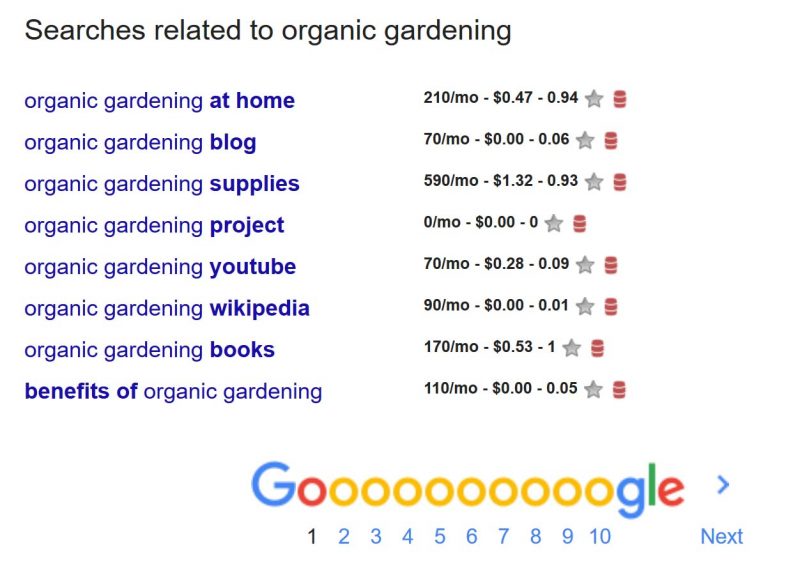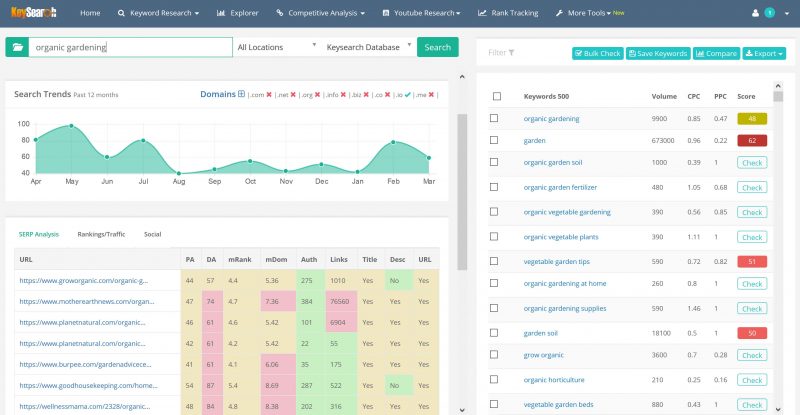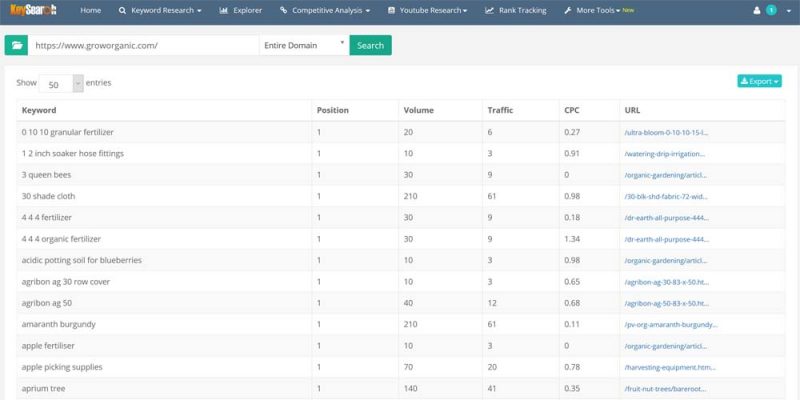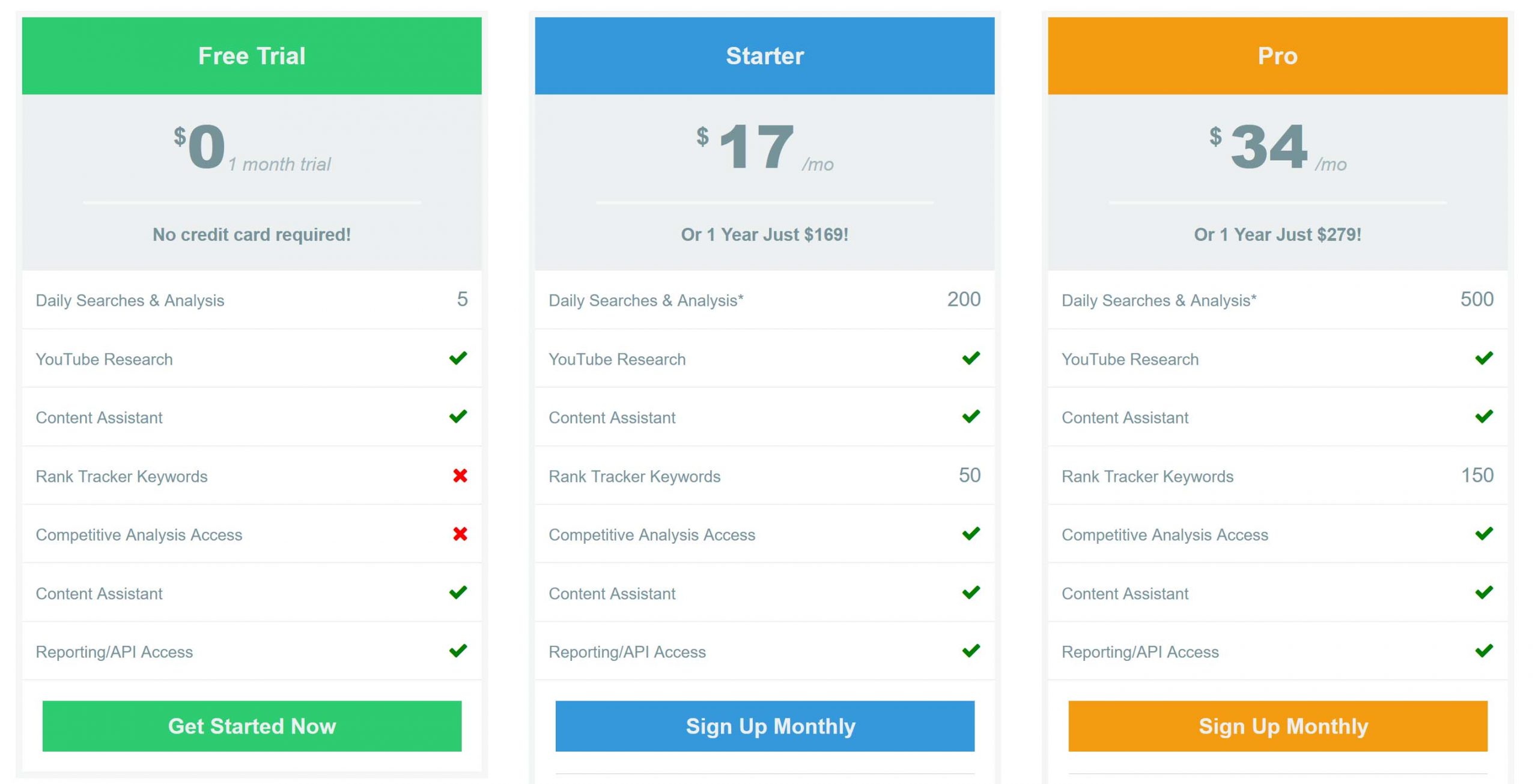Keysearch Review: Easy Keyword Research for 2023
This post may contain affiliate links. For more information, see my full disclosures here.
This Keysearch review covers how to do keyword research, and why I think Keysearch makes keyword research cheap and easy for 2023.

If you are looking for a better way to find keywords for your blog posts, AND learn how to rank in search engines, you’ve come to the right place.
In this Keysearch tutorial you will learn:
- How to start keyword research.
- Where to find keywords for your blog posts.
- How to use Keysearch to find the BEST keywords.
I’ll also cover why I love this keyword reseach tool, in this Keysearch review.
How to Start Keyword Research
If you want your blog posts to rank in search engines, finding the right keywords is an important part of the writing process.
Why do you want your blog posts to rank in search engines? Because ranking blog posts bring traffic to your website, and website traffic leads to sales and conversions. Therefore, you can make more money with advertising, affiliate marketing, and your own products and services; if your blog posts rank on the first page of search engines.
If you are blogging for fun, you don’t need to worry about any of this. However, if you are blogging for business and profit; keyword research will help you build traffic and increase your blogging income.
What is a Keyword?
A keyword is a word, or phrase, that is relevant to your blog post topic.
For instance, a gardening blog might have a post on organic gardening. Organic gardening is a keyword. While this keyword phrase seems like a good keyword, it is not the best keyword for a beginner to intermediate blogger. Why? Because it is a keyword that is hard to rank for. I’ll go over this in more detail in the section that covers how to use Keysearch.
What Makes a Great Keyword?
A great keyword is one that has a high search volume number AND is a keyword you can rank for.
Search volume means the number of times individuals search for that word or phrase. Ranking means where your post is ranked in a search engine like Google. The top 3 results, on page one of a search engine, get the most clicks.
Too many bloggers choose keywords that they will never be able to rank for. They spend hours on a blog post that few people will see.
Also, many bloggers choose keywords no one is searching for. If you rank on the first page of Google for a keyword that gets searched ten times a month, you won’t receive much traffic from your keyword.
Finding a keyword, or phrase, that numerous people search for is step one. Most importantly, finding a related keyword, or phrase, that YOU can rank for is step two.
Why Should I Care About Ranking?
As I mentioned above, if you are blogging for fun; you don’t need to worry about keywords and ranking. However, if there is any chance you want to make money from your blog; finding the right keywords, and ranking for those keywords, will get you closer to making more money from your blog and blog posts.
For example, say you love a product and the company asks you to be an affiliate. They’ll pay you a percentage for every sale that comes from your website. If you write a review that doesn’t rank, you’ll get very little traffic and consequently even fewer clicks to the company you are working with. However, if you spend a little extra time on finding the right keyword that you can rank for, you’ll get hundreds or thousands of clicks. More clicks equals more sales equals more money.
Use this strategy for numerous posts and you can also get advertising income, in addition to affiliate income, from your high traffic numbers.
Where to Find Keywords for Your Blog Posts
There are a number of ways in which you can find keywords. Above all, the key is in finding the best keywords for your blog and blog post.
Start out with the topic of your blog post. For example, organic gardening. This is a pretty broad topic that can be broken down into multiple categories and blog posts.

First of all, you can start by typing organic gardening into Google. Scroll to the bottom of the search engine results and you’ll see “searches related to organic gardening”. This information is based on real data, from real people, searching for information on these topics. These are new keywords and phrases you should consider.
Next, you can also do the same on Pinterest, and other social media platforms. Use the Pinterest search bar to search for your main keyword and see what additional keywords come up.
My post on how to find top ranking keywords goes into this in more detail.
What Goes Into a Top Ranking Blog Post?
Your first step in creating a top ranking blog post is to come up with a topic, and a list of keywords related to that topic. Use Keysearch to find the most relevant keyword you can rank for, that also has a high search volume.
Next, you’ll want to use your keyword (naturally) in your blog heading/title, URL, subheadings of your post, your post’s meta description, and throughout your blog post content. You’ll also want to find related keywords that you can rank for. Keysearch can help with that.
In addition, linking internally and externally is important as well. You’ll want to link to related posts within your own blog, and externally to relevant resources.
Any images should be tagged with your keyword and related keywords.
Finally, you’ll want to make sure that your blog post is as long, if not longer, than the posts you are trying to outrank. This means using Keysearch to determine the word count of the top 3 to 5 blog posts on 1st search results page for your keyword.
Read on to find out how Keysearch can help you achieve all of the above quickly and easily.
What is Keysearch?
Keysearch is a keyword research tool that offers a variety of helpful features. You can use Keysearch to find low competition keywords, track your SEO efforts, get an overview of how your own website is ranking, spy on your competitors, and so much more. Plus Keysearch is cheap in comparison to some of the other keyword research tools that are available.
The Best Keyword Research Tool
Write Better Posts with Keysearch
How to Use Keysearch to Find the Best Keywords
You can use the Keysearch keyword tool to take you several steps further in your keyword research process. It’s easy to use and comes packed with a ton of useful features.
Simply enter your keyword into the Keysearch Keyword Research tab and you’ll learn:
- The search volume for that keyword.
- The top ten websites that rank for that keyword.
- How difficult it will be for YOU to rank for that keyword.
- PLUS hundreds of alternate low competition keywords.
You can choose an alternate keyword as your new keyword. Or you can add it into your post as an additional keyword. Sometimes the alternate keywords end up being better options for ranking. However, they often make for good subheadings as well.
Keysearch Keyword Research Tips
Keysearch comes with several unique and interesting features. Following are some of the features I like the best, as well as tips on how to use them.
Keywords and Keyword Difficulty checker
In the image above you can see that I used the keyword phrase “Organic Gardening” as an example. On the right hand side, of the image, you can see that approximately 9,900 people search for the term organic gardening per month. This is a great search number. However, the keyword difficulty score of 48, and the yellow color, tells you that this term is more difficult to rank for.
To clarify, if you are a new blogger, you want to check the additional keywords until you find a blue or green bar (and a keyword) that has a good search volume number. Keep in mind that finding a blue bar is like finding a unicorn, so look for green and be super happy if you find blue.
- Blue means keyword competition is easy.
- Light green means keyword competition is fairly easy.
- Green means keyword competition is moderately easy.
- Yellow means keyword competition is moderate.
- Light red means keyword competition is difficult.
- Red means keyword competition is very difficult.
Finding LSI Keywords
You can also click on the Deep Analysis button (not shown in the image above) to get a list of LSI keywords, also known as latent semantic indexing. In other words, highly relevant keywords. Sometimes these keywords end up working better than your original keyword. Or you can use these LSI keywords within your post as subheadings, and additional content.
SERP Analysis
Another great feature, of Keysearch, is the SERP Analysis. Otherwise known as the Search Engine Results Page Analysis. This is a list of the top websites that are ranking for your particular keyword. You can find those on the left hand side of the above image. This information is extremely valuable. It tells you whether the keyword is used in the posts title, meta description, and URL; as well as how difficult it will be for you to outrank that post. The more green you see, the better. This means that you can likely write a more effective post that will eventually land in the top 10 search engine results.
My Lists
Keysearch allows you to create lists, and save keywords, so that you can refer back to them. I personally use this feature to save keywords I come across for later posts, as well as for current posts I am working on. For example, I have a list of easy ranking keywords. These are keywords I know I should be able to rank for, based on my research. Once I write a post, I’ll wait one to two months and check back to see if I am ranking for that keyword.
Backlink Checker
The Backlink Checker lets you check your website and posts for backlinks. You can also check your competitor’s websites and posts as well. Backlinks tell search engines that your content is popular. The more popular your content is, the higher chance you have of it getting ranked in the top 10. This feature helps you to determine whether you need to up your backlink game.
Keysearch Review Professional Tip: While backlinks are an important part of your SEO strategy, I truly believe that good content will lead to backlinks over time. Focus your efforts on writing the best long form posts you can, rather than on backlink strategies. And never pay for backlinks. If you do, you may get black balled from search engines. And once that happens, it is very hard to overcome.
Page Analyzer
The Page Analyzer feature is a great way to analyze your completed posts. Simply input your post URL and Keysearch will tell you what you need to fix to best optimize your post. Some items you will be able to fix on your own. Other items may be theme related.
Competitive Analysis Tool
Spy on your competitors! This has to be one of the best parts of Keysearch. It’s definitely one of my favorites. Learn more in the next section.
These are just a few of the many features of Keysearch, and how they can help you with your posts and SEO. You can learn more about keyword research, and SEO, in my SEO tips and tricks post.
Is Keysearch Worth it?

First of all, Keysearch is an amazing keyword research tool at an affordable price. Secondly, Keysearch is one of the easiest keyword research tools to use for your online business and blog.
Let’s get real for a moment. Blogging is not without its costs. If you can save some money here and there, why not? However, if you have the money to spend, you can certainly try a more expensive keyword research tool that offers more features. Again, if you want something that is easy to use and comes at a fair price, then try Keysearch.
Keysearch gives you all the information you need to figure out keyword difficulty, and choose the right keyword that you can rank for.
Keysearch also lets you check what keywords other websites are ranking for. This means you can see what keywords your competition is ranking for, as well as if there are any keywords you are missing that you can rank for. This is where the Competitor Analysis tool comes in. (Again, one of my favorite parts of Keysearch.)
For example, we learned that GrowOrganic.com ranked first for the key phrase “Organic Gardening”. If we enter GrowOrganic.com into the search bar of the Competitive Analysis tool, we get a list of all of the keywords the site is ranking for. In addition, we get the search volume numbers and search engine results position. This is a great way to come up with a list of new keywords and blog post ideas. It’s also a great way to see what your competitors are writing about and ranking for.
Keysearch Content Assistant Feature
In addition to keyword research, Keysearch takes things a step further with their Content Assistant. Enter a keyword like “Organic Gardening” and you will receive the usual keysearch difficulty score. However, you’ll also receive additional information such as:
the average word count of first page search results
This tells you how long the blog posts are, that rank on the first page of search engines. You’ll want to create a post of similar length, or even longer, to outrank those posts. Search engines favor long form content. A short and sweet post won’t get you to the number one spot. So be prepared to spend some time on the posts you want to rank.
recommended keyword meter (Keysearch Must Words – LSI keywords)
These Keysearch “Must Words” are words that the top ranking bloggers, for your keyword, are using. You’ll want to use these additional keywords throughout your post, to help boost your ranking.
Related Keywords and Top URL Keywords
Related keywords are additional keywords you might want to consider using as well. Top URL keywords are the top traffic getting keywords for the 1st ranked Google result.
Research Help
The research section shows you content snippets of ranking posts for your keyword. You can view the post right in Keysearch, or click a link to be taken to the article. This helps you to do your topic research more quickly. You can see what other bloggers are writing about, and how they are formatting their posts.
Popular Questions
The questions section are actual questions people are asking on the internet in places like Quora etc. This area is helpful to learn what people are searching for regarding your keyword. It might help you to identify an appropriate title for your post. In addition, it might help you to create subheadings within your post. For example with Organic Gardening, someone might ask “Is organic gardening worth the cost?” This simple question can give you a whole additional subheading and section to your blog post.
SERPS – Search Engine Results
The SERPS tab gives you the 1st page search results from Google. Here you’ll see each posts heading, URL, and word count for the top ranking posts. This is a good snapshot of whether these bloggers are using the keyword in their heading and URL. If not, you might be able to outrank them.
Final Post Review
Back in the main section of the Content Assistant, you can start to type your post (or upload a post) and it will highlight the recommended keywords you are using and will show you your word count. This is a great way to create new keyword rich posts, or update old posts. Keysearch shared a video of how they updated a post using this feature. After a week, their post jumped up in the search engine rankings.
Keysearch YouTube Research
If you create videos for YouTube, you’ll want to check out the Keysearch YouTube Research feature. This section is specifically for YouTube keyword research and ranking. In other words, with this tool you can generate keywords, track your competition, and see where you rank.
Keysearch Rank Tracking
Another cool Keysearch tool is Rank Tracking. Here you can submit your URL (or any URL) and find out what keywords you are already ranking for. Add those keywords to your account and you can track search volume, your rank, and whether your rank has increased or decreased for that keyword over time. You can also add a keyword that you would like to rank for, and watch it over time.
Keysearch Pricing
Keysearch is relatively inexpensive compared to other keyword research tools. Their basic starter plan is $17 a month and their pro plan is $34 a month. An annual basic starter plan is $169 for the year and the pro annual plan is $279 for the year. (Prices current as of 07/2023.) Most importantly, you can also try Keysearch free for a month. No credit card is required.
I personally have the annual basic plan and find it suits my needs perfectly. Use my Keysearch discount code, in the conclusion section below, for 20% off.
Keysearch Review Conclusion
In conclusion, there are numerous keyword research tools available. Some are free and can help you get by with the basics. However, if you really want to up your keyword research game, you should invest in a tool that is easy to use and has numerous features.
I personally have an annual Keysearch membership and have been extremely happy. The free programs don’t come close to offering the same amount of features. Other tools might have more features, but come at a much higher price. Therefore, I believe that Keysearch is perfect for beginning to intermediate, and even advanced bloggers.
To learn more about Keysearch Click Here, and enter the Keysearch coupon code KSDISC for 20% off.
If you’ve tried Keysearch, or another keyword research tool, share your thoughts in the comment section below.



